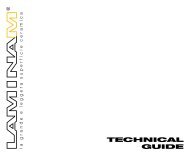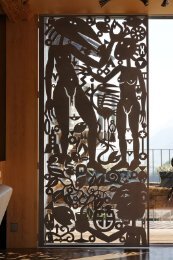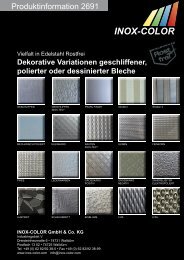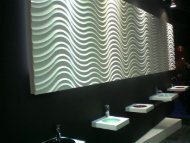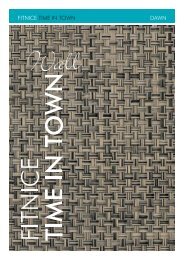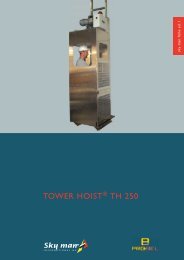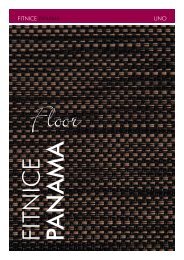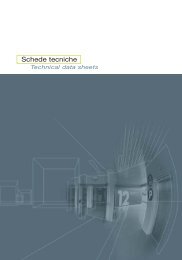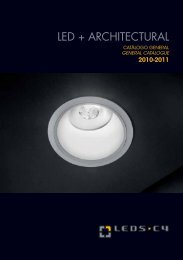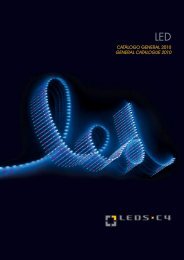Oltre il metallo -1- 20101112 p.1 - 42.cdr - DieMMe
Oltre il metallo -1- 20101112 p.1 - 42.cdr - DieMMe
Oltre il metallo -1- 20101112 p.1 - 42.cdr - DieMMe
Create successful ePaper yourself
Turn your PDF publications into a flip-book with our unique Google optimized e-Paper software.
Integrab<strong>il</strong>ità controsoffitto<br />
False ce<strong>il</strong>ing integrab<strong>il</strong>ity<br />
SADIRADIUS: the advantages of panel systems<br />
High air quality<br />
With no f<strong>il</strong>ters or condensation<br />
trays in the terminal installed in<br />
the occupied space, there is no<br />
dust and dirt bu<strong>il</strong>dup, and hence<br />
the risk of proliferating bacteria is<br />
eliminated.<br />
Comfort<br />
Ch<strong>il</strong>led ce<strong>il</strong>ing systems assure<br />
better results than traditional<br />
systems as the cooling effect is<br />
achieved mostly by means of<br />
radiation. This minimizes heat<br />
transfer by convection, which<br />
involves high airspeed in the<br />
occupied space and evaporation<br />
( s w e a t i n g ) , c o n s e q u e n t l y<br />
resulting in discomfort. The<br />
positive effects for occupants<br />
translate into a considerable<br />
reduction in absences and <strong>il</strong>lness<br />
as well as increased productivity.<br />
S<strong>il</strong>ent running<br />
Ch<strong>il</strong>led ce<strong>il</strong>ing systems are<br />
absolutely noise-free. There are<br />
no fans or speed reduction units<br />
in the occupied space and airflow<br />
inside ducts is reduced to the<br />
value strictly necessary for an air<br />
c h a n g e m e e t i n g h y g i e n e<br />
requirements. Hence occupants<br />
work in an extremely quiet<br />
environment, resulting in<br />
improved concentration levels<br />
a n d t h u s u n b e a t a b l e<br />
performance.<br />
Sound insulation<br />
Thanks to its special construction,<br />
the radiant panel makes a<br />
horizontal sound barrier. All<br />
HVAC system components are<br />
housed behind the false ce<strong>il</strong>ing:<br />
there is no risk of sound<br />
conveyance through ducts or fan<br />
co<strong>il</strong>s. Sound insulation, therefore,<br />
is assured between the various<br />
rooms should partitioning walls<br />
be installed to alter the space’s<br />
layout.<br />
Reduced energy consumption<br />
Compared to all-air systems,<br />
r a d i a n t p a n e l s p r o d u c e<br />
considerable energy savings as<br />
water is a much more effective<br />
energy carrier than air. Unlike a<br />
mixed system, no energy is<br />
needed to run terminal fans.<br />
Generally speaking, energy<br />
savings also derive from the fact<br />
that, during summer operation,<br />
the mean radiant temperature<br />
(perceived by the occupants) is<br />
lower than that of the air. Hence<br />
you can achieve the same comfort<br />
c o n d i t i o n s w i t h a n a i r<br />
temperature 1-2°C higher than<br />
with the traditional system (27-<br />
28°C instead of 26°C). Vice versa,<br />
in winter mode, comfort<br />
conditions can be maintained<br />
with a lower space temperature<br />
(18-19°C instead of 20°C). Other<br />
energy savings can be achieved in<br />
producing primary fluids (cold<br />
water and hot water). If there is a<br />
water source ava<strong>il</strong>able with a<br />
temperature lower than 16°C<br />
(sea, lake, river or water bed), it<br />
can actually be used for total or<br />
partial cooling of the water<br />
circulated in the circuit supplying<br />
the panels by means of a heat<br />
exchanger. In between seasons,<br />
cold water can also be produced<br />
with freecooling cycles using a<br />
cooling tower. In winter mode,<br />
the use of hot water at a low<br />
temperature (35°C) means highefficiency<br />
heat production<br />
systems can be used, such as<br />
condensation bo<strong>il</strong>ers or heat<br />
pumps.<br />
Maintenance free<br />
Maintenance costs are practically<br />
n<strong>il</strong>, given that there are no<br />
components such as fans or<br />
f i l t e r s . I t i s a l s o w o r t h<br />
remembering that the systems are<br />
out of reach of users, meaning<br />
they cannot be tampered with or<br />
damaged. For access to the false<br />
ce<strong>il</strong>ing, each panel can be<br />
released and removed or opened<br />
like a trapdoor, remaining<br />
attached to the structure.<br />
Space exploited to the full<br />
Radiant panels, by definition, do<br />
not take up floor space. They<br />
feature a streamlined design,<br />
which fac<strong>il</strong>itates installation even<br />
i n b u i l d i n g s u n d e r g o i n g<br />
renovation. Compared to all-air<br />
systems, the size of primary air<br />
ducts and treatment units can be<br />
reduced drastically. Air volume is<br />
actually usually limited to the<br />
need to provide vent<strong>il</strong>ation and<br />
control humidity. In this sense,<br />
ch<strong>il</strong>led ce<strong>il</strong>ings can therefore be<br />
compared to mixed systems.<br />
Looks<br />
Radiant panels look exactly the<br />
same as passive panels. The only<br />
visible element of the HVAC<br />
system consists in the air<br />
d i f f u s e r s . Te r m i n a l s a r e<br />
nonetheless small in size and<br />
linear types can be bu<strong>il</strong>t into the<br />
structure holding up the false<br />
ce<strong>il</strong>ing.<br />
Flexib<strong>il</strong>ity<br />
The system assures unbeatable<br />
flexib<strong>il</strong>ity when it comes to the<br />
false ce<strong>il</strong>ing’s configuration.<br />
Radiant panel dimensions can<br />
actually be determined based on<br />
false ce<strong>il</strong>ing geometry and type<br />
and the face module.<br />
9.10



